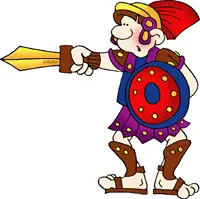Ancient Roman Barbarians
The word barbarian is somewhat misleading in historical terms. In ancient Greece barbarians were referred to people who did not speak Greek.
Later in ancient Rome barbarians were people that did live within the Roman Empire. The ancient Romans referred to many groups of people as barbarians.

They felt the barbarians did not have the same values, education, government systems, and the engineering skills of the ancient Romans.
The barbarians believed in different religions, wore different clothing, and even ate different foods which were native to their areas.
During the later stages of Roman Empire and its decline, barbarians became more powerful.
These groups of barbarians came from many areas within Europe, Africa, and Asia.
Ancient Rome and the different groups of barbarians
To the Romans barbarians were a group of people that were not part of the Roman Empire.
There were stark differences between the groups of barbarians that helped in the decline of the Roman Empire. Here is a quick look at some of the different groups of barbarians that contributed to the fall of the Roman Empire
The Goths were an organized and influential group of barbarians. There were two types of Goths that included the Ostrogoths and Visigoths. During the late 4th century C.E. the Visigoths were the more powerful of the two groups.

The Visigoths had no problem going to war with the Roman Empire. They eventually controlled a lot of Western Europe and in 410 C.E. under the leadership of Alaric I the Visigoths plundered Rome.
The Vandals originated in Northern Europe and moved to Hispania also known as the Iberian Peninsula which is present-day Spain. From there they moved to North Africa where the Vandals formed a large an influential kingdom.
The Vandals signed a peace treaty with Rome in 422 C.E. They would later attack Rome in 455 C.E. under the leadership of King Genseric where they sacked the city for more than two weeks.
The Huns were a nomadic barbarian tribe that originated in the East and Asia.
They liked to fight against their enemies. Attila the Hun is their most famous leader. He defeated the Ostrogoths and then the Eastern Roman Empire.
They continued onward to conquer Roman Gaul or present-day France. During the year of 452 C.E. the Huns entered Italy and raged war on most of the peninsula but they never did sack the city of Rome.

The Franks were composed of numerous Germanic tribes who migrated to present-day France. Around the beginning of the 4th century C.E. the Franks started to invade the Roman Empire.
The Franks gained more influence in the area after the fall of the Western Roman Empire. Over time the Franks became one of the more powerful empires in Western Europe.
The Saxons were a force against the ancient Romans as the empire began to fall apart. They migrated from Western Europe and eventually invaded Great Britain.
The Saxons marched through Great Britain and conquered numerous Roman settlements.
The Romans in Great Britain were at a huge disadvantage because the Roman Empire and Emperor could not afford to send an army to help their settlements in Great Britain.
There were other groups of barbarians that bothered the Romans. These groups were smaller and less organized over time.
The groups include the Lombards, Celts, Parthians, Thracians, Burgundians, and the Picts.
Facts about ancient Roman Barbarians
- Barbarian was used a general term by the ancient Romans and referred to people that did not live within the Roman Empire.
- Barbarians believed in different gods, ate different food, and wore different clothing styles.
- The ancient Romans thought the barbarians were inferior because they lacked education, engineering skills, and a formal government system.
- Most groups of barbarians were controlled by kings or a monarch system.
- The first group of barbarians to sack Rome was the Visigoths in 410 C.E. under the leadership of Alaric I.
- The Romans had many barbarian tribes as allies. The Roman Empire would enlist the help of barbarian tribes to fight against other barbarian tribes.
- Although Attila the Hun ravaged the countryside of Italy in 452 C.E. they never did plunder Rome.
- The Romans did not refer to the Greeks as barbarians and adopted much of the Greek culture over time. The Romans also incorporated other aspects of barbarian culture that benefitted the Roman Empire.
Questions and Answers
1. Most barbarian tribes were led by what type of government system?
A king or monarchy
2. Who was the leader of the Visigoths that sacked Rome in 410 C.E.?
Alaric I
3. Where did the Franks eventually settle?
Present-day France
4. What portion of the Roman Empire did the Saxons begin to invade?
Great Britain
5. Who is the most famous leader of the Huns that invaded the Eastern Roman Empire?
Attila the Hun



